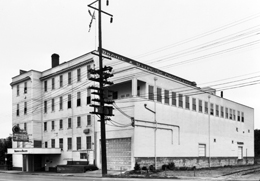In the spring of 1923, Tacoma confectioner Harry Brown (ca. 1893-1960) creates a butter-crunch toffee enrobed in milk chocolate and then encrusted with chopped almonds. Pleased that the almond coating makes the candy less messy to consume than ordinary chocolate-coated toffee, Brown hands out samples to many Tacoma residents, including Tacoma Public Library librarian Jacqueline Noel (ca. 1881-1964). Asked what the new confection should be called, Noel dubs the candy Almond Roca.
Brown & Haley
Harry Brown was a partner in the Tacoma candy company Brown & Haley. Company lore holds that Jacqueline Noel chose the components of the candy's name because its relatively hard crunch was somewhat rock-like. At the time, many almonds were imported from Spain and "roca" is a Spanish word for rock.
Harry L. Brown and Jonathan Clifford Haley (ca. 1885-1954) became acquainted at church in 1908. At the time, Brown owned a candy store and Haley was a sales representative for the Schilling spice company. The pair began working toward creating a business together in 1912, and incorporated the business as Oriole Candy Company, the predecessor to Brown & Haley, in 1914. Brown & Haley observes 1912 as the founding date of the company. By 1916, Brown & Haley was producing a confection called the Mount Tacoma Bar (later renamed the Mountain Bar), a log of vanilla fondant dipped in chocolate. (Fondant is a creamy candy made by cooking sugar, liquid, flavoring, and sometimes corn syrup and an acid such as vinegar or lemon juice, until it reaches 238-240 degrees Fahrenheit.) During World War I, Mount Tacoma bars and other Brown & Haley confections became popular with soldiers stationed at Camp Lewis (now Joint Base Lewis-McChord) not far from the company's location in Tacoma.
J. C. Haley handled sales and marketing for Brown & Haley, while Harry Brown assumed responsibility for product development. He created the first batch of Almond Roca in the large copper candy kettle the company used to cook sugar. Copper, an excellent heat conductor, was (and remains) an effective material for vessels in which sugar is liquefied and cooked to high temperatures. Almond Roca's recipe is proprietary, but in general toffee ingredients include sugar, butter, vanilla, and flavoring. Almond Roca's log-like shape allowed bite-sized pieces to be wrapped individually. The candy's golden foil wrapping became part of its signature look.
The Candy That Travels
During its first few years, Almond Roca was shipped in traditional cardboard candy boxes, or in decorative wooden boxes adorned with photographs of Northwest scenes. In 1927, Brown & Haley began shipping Almond Roca in sealed airtight tins in order to ensure the candy's freshness. Almond Roca was marketed under the slogan "The Candy That Travels," and the innovative tins were dubbed "vita-pack." Almond Roca tins were opened with an accompanying key that, when turned, pulled back a thin strip of sealing material, revealing the gold-wrapped candies. For a time, Brown & Haley advertisements exploited this feature, using the tag line "Candy so good we lock it up tight." Almond Roca was shipped to American soldiers serving overseas during World War II, and later in Korea. The chocolate coating extended the candy's shelf life and the airtight tins protected it from vermin.
During World War II, when sugar was strictly rationed, Brown & Haley chose to focus production on the firm's best-selling confections, the Mountain Bar and Almond Roca. The United States War Department selected Almond Roca as one of the American products that would be available in United States canteens around the world. This made the company a direct participant in the war effort and ensured it a supply of sugar sufficient to maintain production. Brown & Haley advertisements of the period emphasize how much Almond Roca was being shipped to soldiers: "More Almond Roca is being made today than ever before," read a May 7, 1945, advertisement in The Seattle Times. "But you may not find any. Almost every pound goes overseas to bring a bit of comfort to our armed forces" (Display ad, p. 4). This worldwide availability also exposed overseas markets to Almond Roca. The candy became popular with various celebrities, including mountaineer Edmund Hillary (1919-2008), who carried the treat with him on many ascents.
Brown family members formally ended their association with Brown & Haley in 1944, selling their interest to the Haley family. By 2016 forty percent of all Almond Roca confections (and more recent innovations such as cashew, macadamia, peppermint, and sugar-free Roca) were exported, making Brown & Haley the highest-volume confectionary exporter in the United States. Customers purchased the candy in many settings, from highbrow London luxury-goods stores to commonplace Australian variety stores to airport gift shops to American pharmacies. The candy became an overwhelming favorite in China, where the golden foil wrappers and pink and red packaging were considered auspicious. "Roca" can mean "happy family" in Cantonese. Other countries where Almond Roca has become popular include Canada, Japan, Singapore, Taiwan, Korea, Saudi Arabia, the Philippines, and the United Arab Emirates, among others. As of 2016 Brown & Haley had sent more than 5 billion bite-sized morsels of Almond Roca from the modest downtown Tacoma factory into the hands and mouths of citizens of countries around the globe.

